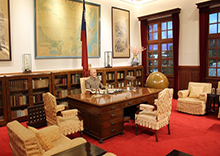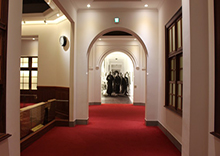
Chiang Kai-shek was the Republic of China’s longest-serving head of state, being 1st through 5th-term President. His life is tightly intertwined with the history of the Republic of China. To give the public a glimpse into the nation’s development, this exhibit is presented to explore Chiang’s participation in the revolutionary period, the Eastern Expedition, the Northern Expedition, the Second Sino-Japanese War, the government’s postwar relocation to Taiwan, and the shifting international situation through artifacts, files, and photos.
Early life and revolutionary times
From 1908 to 1910, Chiang Kai-shek trained at the Tokyo Shinbu Gakkō military school in Japan. The revolutionary fervor in China began affecting students abroad, and in the first year of his training, Chiang joined the Tongmenghui (United Allegiance Society) headed by Sun Yat-sen. Choosing the name “Republic of China” for the nation they envisioned, the Society set out a revolutionary course. Following the Xinhai Revolution (aka the Wuchang Uprising), the Republic of China Nanjing Provisional Government was established January 1, 1912, with Sun Yat-sen as first Provisional President. In February, Sun stepped down in favor of Yuan Shikai. Yuan soon overstepped his mandate, and in 1913, a second revolution against his criminal regime began. After this failed, Yuan disbanded the Parliament and annulled the Provisional Constitution then in effect. Sun Yat-sen then fled to Japan and, in 1914, founded the Chinese Revolutionary Party (reorganized as the Kuomintang in 1919), and began planning a third revolution. In 1913, Chiang pledged to join the Chinese Revolutionary Party while it was still being formed as he actively opposed Yuan Shikai. In December 1915, Yuan announced the creation of a monarchy, renaming the country the Empire of China, ending the legal rule of the Republic of China. Yuan’s crowning of himself as emperor led to mass protests. Cai E led the National Protection Army from Yunnan in opposition, and the Chinese Revolutionary Party followed suit. After only 83 days of nationwide protests, Yuan succumbed to pressure and dissolved the monarchy, dying on June 6, 1916.
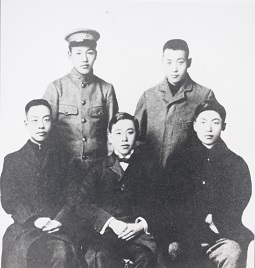
- Chiang in a group photo with classmates of Tokyo Shimbu Military Academy in 1908.
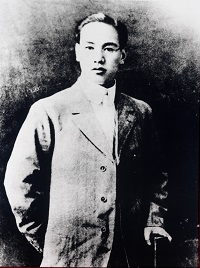
- Revolution, which led to the establishment of the Republic of China in 1911.
Whampoa Military School, the Northern Expedition, and the Provisional Constitution of 1931 for the Period of Tutelage
The death of Yuan Shikai ushered in the Beiyang Government period, marked by warlord fiefdoms and constant warfare. After Premier Duan Qirui defeated the effort by Gen. Zhang Xun to restore the Manchu emperor to the throne, but did not seek to ensure the constitutional governance of the ROC. In response, Sun Yat-sen established the ROC Military Government in Guangdong in 1917 and led the Constitutional Protection Movement. In 1922, Guangdong warlord Chen Jiong-ming revolted, and Sun fled to the gunboat Yongfeng. Chiang Kai-shek traveled to Guangdong to help direct military efforts and rescue Sun from danger. Sun believed that the failure of the revolution could be traced to the fact that the Revolutionary Party was not sufficiently well-armed or trained. In 1924, he ordered Chiang to establish the Whampoa Military Academy. Chiang served as first commandant, training the National Revolutionary Army to serve as the main force for the Northern Expedition, the necessity of which was already foreseen. This marked the beginning of Chiang’s foray into politics. Chiang took command of the National Revolutionary Army in July 1926 and launched the Northern Expedition. After this proved a success, Chiang became Chairman of the National Government, and the country entered a period of political tutelage. The Provisional Constitution of the Republic of China for the Period of Political Tutelage was drafted in May 1931. It served as the basis of law for the country prior to the passage of a full constitution. It took effect on June 1, putting into motion Sun Yat-sen’s vision of moving from a period of military rule, through one of political tutelage, and finally to one of constitutional governance.

- Chiang in a group photo with Sun Yat-sen and other Kuomintang figures after the opening ceremony at the Whampoa Military Academy on June 16, 1924.

- Chiang reviewing the troops, as the Chairman of the Nationalist Government, in celebration of the completion of the Northern Expedition on October 10, 1928.
The Mukden Incident and the Xi’an Incident
On September 18, 1931, Japan took advantage of turmoil in China, launching an invasion of Manchuria. This brought three northeastern provinces under its control. The people came together to oppose Japan, demanding that infighting end and the nation unite to battle Japan. The ROC government’s policy of achieving internal cohesion before addressing foreign adversaries had failed to gain popular support. In December 1936, Chiang Kai-shek was imprisoned during the Xi’an Incident, after which he stepped down and began his wilderness period. The Xi’an Incident created conditions for cooperation between the Kuomintang and the Chinese Communist Party and caused the government to adjust its policies so that a joint fight against the Japanese could be conducted. The period 1937 to 1939 was the high point of cooperation and showed great promise at the beginning. But as the Communists grew in strength, civil strife increased.
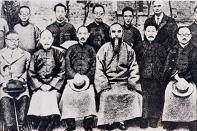
- Chiang in a group photo with members of the Special Foreign Affairs Commission of the Nationalist Government. The commission was formed after the Mukden Incident(also known as the September 18 Incident)to take charge of foreign affairs and appeal to the League of Nations regarding the Japanese invasion.
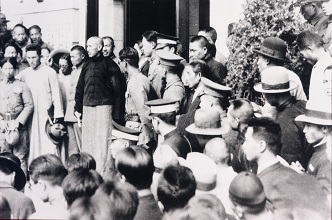
- Chiang receives student delegates from universities in Peiping, Shanghai, and Nanjing. The students volunteered to serve in the military to fight against the Japanese in an attempt to recover Northeastern China, which was lost to Japan in the Mukden Incident.
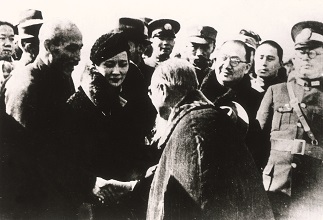
- Chiang welcomed by Nationalist Government officials after returning from Xian on December 26, 1936. Chiang was held in Xian by Zhang Xue- liang and Yang Hu-cheng, an event that is now known as the Xian Incident, which led to the Second United Front, an alliance between Kuomintang and the Communist Party of China in resisting the Japanese invasion.
War with Japan and the Sino-Japanese Peace Treaty
On July 7, 1937, the Japanese army attacked a Chinese position near the Marco Polo Bridge in Hebei’s Wanping County, marking the start of a full-scale assault on China. In the beginning, China was no match militarily for Japan. After struggling alone for four long years, China was joined in the Pacific War by the United States and United Kingdom in December 1941 following Japan’s attack on Pearl Harbor. The Republic of China officially declared war on Japan, and Chiang was deputized as Generalissimo for the China Theater. On January 11, 1943, the Republic of China signed new equal treaties with the US and UK, formally overturning many unequal treaties done by the Qing Empire and ending the practice of extraterritoriality.
From November 22-26, 1943, National Government Chairman Chiang Kai-shek, US President Franklin D. Roosevelt, and British Prime Minister Winston Churchill met in Cairo to discuss war strategy against Japan and the postwar international order. In a press communiqué released after the meeting, the so-called Cairo Declaration, it was declared that all the territories Japan had stolen from the Chinese, including Formosa and the Pescadores, would be restored to the Republic of China.
On August 6 and 9, 1945, respectively, the US dropped atomic bombs on Hiroshima and Nagasaki. On August 15, Japan agreed to unconditional surrender. In Chongqing, Chiang made a radio broadcast announcing Japan’s defeat, calling for world peace, for “forgetting past wrongs and being kind to people,” pledging to repatriate Japanese citizens and POWs in China. Japanese media said that this was an act of “repaying malice with virtue.” In a major victory on the diplomatic front, the ROC became a founding member of the United Nations and its Security Council.
On September 8, 1951, Japan signed the San Francisco Peace Treaty with the victorious powers. The treaty stated that Japan renounced all right, title, and claim to Formosa and the Pescadores, but did not name a recipient state. This is the origin of the Theory of the Undetermined Status of Taiwan. As the ROC was not permitted to attend the San Francisco Peace Conference, under the US’s guidance and in line with Article 26 of the San Francisco Peace Treaty, Japan negotiated a separate peace with the ROC. On April 28, 1952, ROC Representative George Yeh and Japanese Representative Isao Kawada signed the Treaty of Peace between the Republic of China and Japan in Taipei.

- Chiang and Madame Chiang in a photo with U.S. President Franklin D. Roosevelt and British Prime Minister Winston Churchill at the Cairo Conference in November 1943.
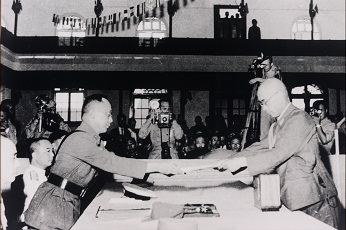
- He Ying-qin, Commander-in-chief of the Chinese Army in the China War Zone, receives the Japanese Instrument of Surrender from Kobayashi Asasaburo, Chief of Staff of the Japanese China Expeditionary Army on September 9, 1945.
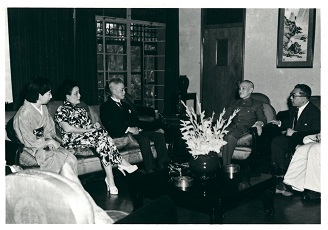
- The Treaty of Taipei was signed on April 28, 1952, at the Taipei Guest House. When Chiang Kai-shek received the Japanese delegation headed by Plenipotentiary Isao Kawada on 30 April, he noted that given the exclusion of the ROC from the San Francisco Peace Treaty, a separate peace agreement with Japan would be meaningful.
The ROC takes control of Taiwan; early postwar governance of Taiwan
On August 15, 1945, following Japan’s unconditional surrender, and in accordance with UN Supreme Allied Commander’s General Order No. 1, the ROC took possession of Taiwan and set up the Taiwan Provincial Government to rule the island. On August 29, Chen Yi was named first Provincial Governor. On September 1, the Regulations on the Organization of the Taiwan Provincial Government were announced, and on September 7, Chen Yi was ordered to also serve as head of the Taiwan Garrison Command. This established the governing apparatus as well as the political and military leaders of Taiwan for the immediate postwar period. With military and political power embodied in a single person, there were no checks and balances. While in charge of Taiwan, Chen Yi governed poorly, with corruption rampant. The people were greatly dissatisfied.
In 1947, a woman was beaten by inspectors for selling contraband cigarettes, leading to the February 28 Incident. National Government Chairman Chiang ordered troops to Taiwan to suppress rioting, but ordered officials not to carry out reprisals. Yet after order was restored, the military continued with indiscriminate arrests and suppression tactics, including launching a village pacification campaign. This caused the deaths of countless elites and innocent bystanders. No attempt was made to prosecute wrongdoers. After a time, Chen Yi was recalled, and Wei Tao-ming sent to serve as the first post-reform Chairman of the Taiwan Provincial Government. This served as a partial nod to the need to reform in the aftermath of the February 28 Incident.
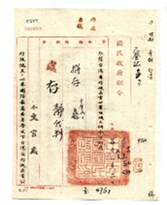
- On August 31, 1945, Chiang Kai-shek ordered the copying and distribution of the Regulations on the Organization of the Taiwan Provincial Government
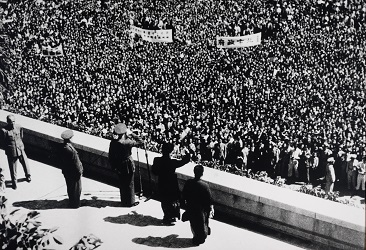
- On October 21, 1946, Chiang traveled to Taiwan for the first time to attend celebrations marking the anniversary of Taiwan’s Retrocession. In his diary,Chiang wrote: “There are no Communist cells in Taiwan. It is a clean land that we should build upon and make into a model province. This tour should make a greater impression in Taiwan than the one taken in the Northeast. At least, I think it will!”
He had completely missed that the people were greatly displeased with the government’smaladministration.
Promulgating the Constitution and becoming First-term President under the Constitution
Chiang played a major role in crafting the ROC Constitution, particularly in bringing modern constitutional principles into the present-day Constitution. On November 28, 1946, Chiang delivered a draft Constitution to the National Assembly. In remarks, he said: “I approve of the draft constitution put forth by the national government. I believe that the provisional constitution is unfit to meet the needs of today.” This was Chiang’s way of making a political pledge to other parties about avoiding a constitution dominated by the Kuomintang. On December 25, the National Assembly at Nanjing passed a resolution adopting the Republic of China Constitution. Chairman Chiang signed the relevant implementation order on behalf of the national government. The Constitution was issued on January 1, 1947, and took effect on December 25 of that year. In 1948, Chiang was elected to serve as First-term President under the new Constitution.
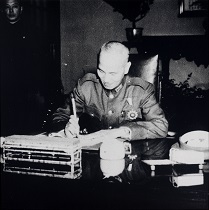
- Chiang signs the Constitution of the Republic of China in December 1946.
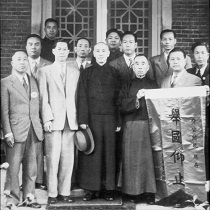
- A delegation of senators from Taiwan Province visits Nanjing and presents a flag to Chiang on May 10, 1948, after Chiang is elected the first constitutional President of the R.O.C.
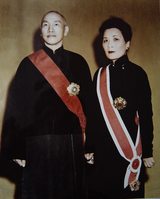
- Chiang and Madame Chiang at the inauguration of Chiang as the first constitutional President of the R.O.C. on May 20,1948.
The government’s relocation to Taiwan and governing of the island
After eight years of war against Japan, tensions between the KMT and the Communists were running high, and military conflict grew more intense. In December 1945, US President Harry Truman dispatched Gen. George Marshall to seek to reconcile the parties. But after a year of efforts, it was admitted by January 1947 that negotiations had failed. In February, full-scale civil war began anew. During the latter part of the civil war, the Nationalists were defeated in the key Liao-shen, Huaihai , and Ping-jin Campaigns, leading to the loss of north China. For the Nationalists, the situation was grim. With difficulties plaguing the nation from both within and without, Chiang announced on January 21, 1949, that he was stepping down. Vice President Li Zong-ren assumed office as Acting President and began negotiating with the Communists.
Before stepping down, Chiang averred that he would start over and prepare for his return. His aim was to transform Taiwan into an anticommunist base. He started by ordering Central Bank Governor Yu Hung-chun to move gold reserves from Shanghai to Taipei and Xiamen. Party and government officials were then shuffled, and Chen Cheng was dispatched to serve as Chairman of the Taiwan Provincial Government (and later head of the Taiwan Garrison Command). Chiang Ching-kuo became Chair of the Taiwan Province Kuomintang, while Fu Ssu-nien took office as head of National Taiwan University. While out of office, Chiang remained Chairman of the KMT, meaning he still held actual power and could direct both the government and the military.
After talks broke down between the KMT and the Communists, and the war continued to go badly, the central government continued to spiral. Acting President Li Zong-ren left the country in November. In December 1949, the government relocated to Taiwan. On March 1, 1950, in Taipei, Chiang declared his return, reassuming the powers of the presidency.
Diplomacy after relocation
After Chiang’s return to power, he faced the great challenge of obtaining foreign aid to bolster Taiwan and ensure that the Republic of China remained the only legal representative of China. The outbreak of the Korean War marked a pivot. The US sent the Seventh Fleet through the Taiwan Strait to deter the Communists. In 1954, the US and the ROC signed the Sino-American Mutual Defense Treaty.
Meanwhile, the Communists were overrunning remaining ROC bases and, in 1954, the First Taiwan Strait Crisis broke out. With the help of the US, the military successfully evacuated Dachen Island. In 1958, Mao Zedong launched an assault on Kinmen, ushering in the Second Taiwan Strait Crisis. With support from the US, the ROC launched a powerful counterattack and gained air superiority, leading to the defeat of the People’s Liberation Army. The security of the Taiwan Strait was assured.
However, the ROC’s international position continued to deteriorate as the People’s Republic of China continued a successful diplomatic expansion. In October 1971, the United Nations passed Resolution No. 2758, giving the China seat to the People’s Republic of China. Following this in a domino effect, many countries broke ties with the Republic of China, leaving the country in the lurch on the global stage.

- During the Second Taiwan Strait Crisis, the US sent Secretary of State John Foster Dulles to meet with Chiang Kai-shek in 1958. On October 23, the two issued a joint communiqué, which contained a key point concerning the ROC’s military reconquest of the mainland: “The Government of the Republic of China considers that the restoration of freedom to its people on the mainland is its sacred mission. It believes that the foundation of this mission resides in the minds and the hearts of the Chinese people and that the principal means of successfully achieving its mission is the implementation of Dr. Sun Yat-sen’s three people’s principles (nationalism, democracy, and social well-being) and not the use of force.”

- From June 18 to 19, 1960, US President Dwight Eisenhower visited Taiwan, releasing a joint communiqué with Chiang Kai-shek in which the two nations pledged solidarity and to help each other resist Communist influence. During the three days President Eisenhower was in Taiwan, the People’s Liberation Army lobbed over 88,000 shells at Kinmen in three attacks.
Economic infrastructure, culture, and education
In 1949, at the beginning of Chen Cheng’s term as Chairman of the Taiwan Provincial Government, he realized that Taiwan’s financial situation was dire. Policies undervaluing the Taiwan dollar and advance central government spending by the local government in Taiwan were crucially flawed, leading to hyperinflation. In mid-1949, the New Taiwan dollar was introduced, with the gold that had been moved by the Central Bank to Taiwan serving as reserves (and rectifying the advance payments issue). Meanwhile, remittances between Taiwan and China were stopped to prevent Taiwan’s fiscal condition from deteriorating. Nevertheless, it was only with the 1950 outbreak of the Korean War and resultant massive support from the United States that the economy finally saw structural improvement. To ensure US funds were well-spent, the first economic infrastructure projects were proposed in 1953. These increased import taxes and forbad some imports to begin the process of import substitution industrialization and, later, to produce goods for export. In line with US suggestions, a total of 19 financial and economic reforms were implemented, including tax policy changes, implementing the Statute for Investment Encouragement, and creating export processing zones. Such moves spurred investment and created jobs.
Concerning education, Chiang led the Chinese Cultural Renaissance movement as a response to the Cultural Revolution in mainland China. To improve national education standards and train up skilled personnel to strengthen the nation, nine-year compulsory education was initiated in 1968. This created the human capital that resulted in the nation’s economic take off in the 1970s.
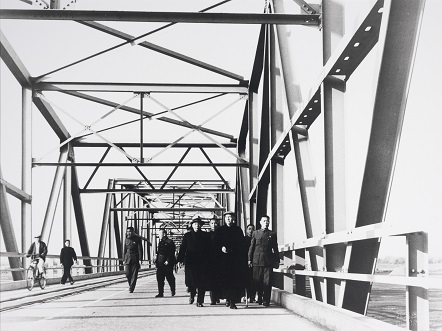
- In 1953, Chiang Kai-shek and Chiang Chin-kuo witnessed the opening of Xiluo Bridge to vehicle traffic on January 28, 1953. With the US providing funding, construction began on May 29, 1952, and finished on December 25.
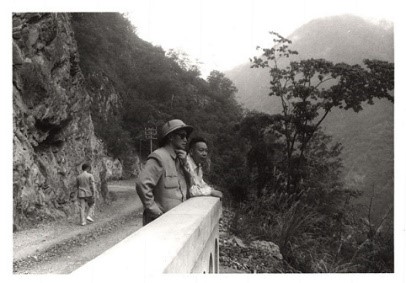
- Chang Kai-shek and Chiang Ching-kuo inspect construction of the Central Cross-island Highway on June 21, 1958. Construction of the highway began on July 7, 1956, with financial and technical assistance from the United States.
Martial Law and the White Terror
With tensions between the Nationalist and Communist governments as background, Taiwan came under authoritarian rule, and the human rights protections guaranteed by the Constitution were not implemented. Chen Cheng announced martial law on May 19, 1949, to come into effect the following day. While this had the effect of allowing for the stable development of Taiwan politically, economically, and socially, it severely infringed upon the freedom and rights of Taiwan’s people. During the long period of martial law, there were many instances of frame-ups and miscarriages of justice. Martial law was used as a weapon to root out dissent, creating countless victims. Among them was Gen. Sun Li-jen who, in 1955, was charged with conspiracy in line with a treason case against his subordinate Guo Ting-liang. Sun spent 33 years under house arrest as a result. In 1960, charges of treason were brought by the Taiwan Garrison Command against Lei Chen, founder of the Free China journal. In 1964, Peng Ming-min, Hsieh Tsung-min, and Wei Ting-chao were arrested for having written the Declaration of Self-Salvation of the Taiwanese People. However, both from within the government and outside of it, many people came together to protest in favor of human rights as well as civil and political rights. As a result of their efforts, Taiwan today enjoys democracy, freedom, and rule of law.
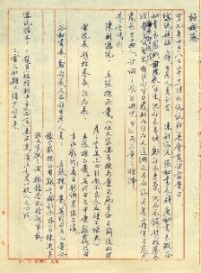
- On October 8, 1960, President Chiang called a meeting to discuss how to proceed against Lei Chen. A section of the report “Investigation into Lei Chen and the Free China bimonthly.”
Presidential confirmations of military justice cases and imposing of extrajudicially harsher sentences
In 1950, President Chiang promulgated the Standards for Approving Ministry of National Defense Military Justice Cases, mandating that the results of military court cases must be read and approved of by the President. Chiang sometimes wrote changes to the severity of punishment right on the court case, raising suspicions of an unjust expansion of his powers. In the Military Tribunal Act of 1956, it clearly states that when the President is reviewing a verdict, where the President believed a verdict inappropriate or illegal, the case should be returned to the courts for reconsideration, but a change to the original ruling is not permitted. Yet even in the wake of this Act’s passage, Chiang still made comments on verdicts. In all, Chiang Kai-shek was involved in changing the sentences of as many as 259 people to the death penalty.
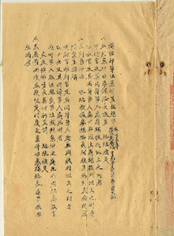
- In 1950, President Chiang promulgated the Standards for Approving Ministry of National Defense Military Justice Cases, which stipulated that the results of military trials were to be submitted to the President for approval.
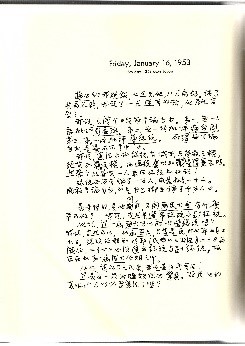
- In his diary, Hu Shih wrote of his January 16, 1953, meeting with President Chiang that he had admonished: “The Constitution only allows the President to have the power to commute and pardon sentences, but never to increase punishment. And yet, the President has repeatedly imposed sentences, which is clearly unconstitutional.”
The Gallery of President Chiang Kai-shek’s Office
The Gallery of President Chiang Kai-shek’s Office, which is a recreation of his original office, was opened to the public on October 31, 1994. All the furniture, accessories and other furnishings are in their original position in the Presidential Office. Visitors can also see an extremely lifelike wax sculpture of President Chiang Kai-shek by renowned sculptor Lin Chien-cheng sitting behind his desk.
Initially, the Presidential Office was located on the west side of Chiang Kai-shek Memorial Hall (near the collection storage room). It was later moved to Room 6 of the Exhibition Hall of Historical Relics of Chiang Kai-shek on the east side of the Memorial Hall. In 2014, to enhance the historical accuracy and spatial atmosphere of the display, President Chiang’s original office (currently called Taiwan Green Hall) was measured, restoring the corridor, Reception Room and Presidential Office in all their original glory. Multimedia content was also added as part of the display to enhance the visitor experience. The newly restored gallery was reopened to the public on January 20, 2015.
From photographs at Academia Historica, it is clear that the furniture in the Presidential Office, including the desk, was rearranged many times. Moreover, the ROC flag, bookcases, Madame Chiang’s paintings, maps and other decorative items served as background, with vases, gifts from friends, engravings and a globe frequently appearing in images of the office. The re-creation creates a scene that almost appears frozen in time.
